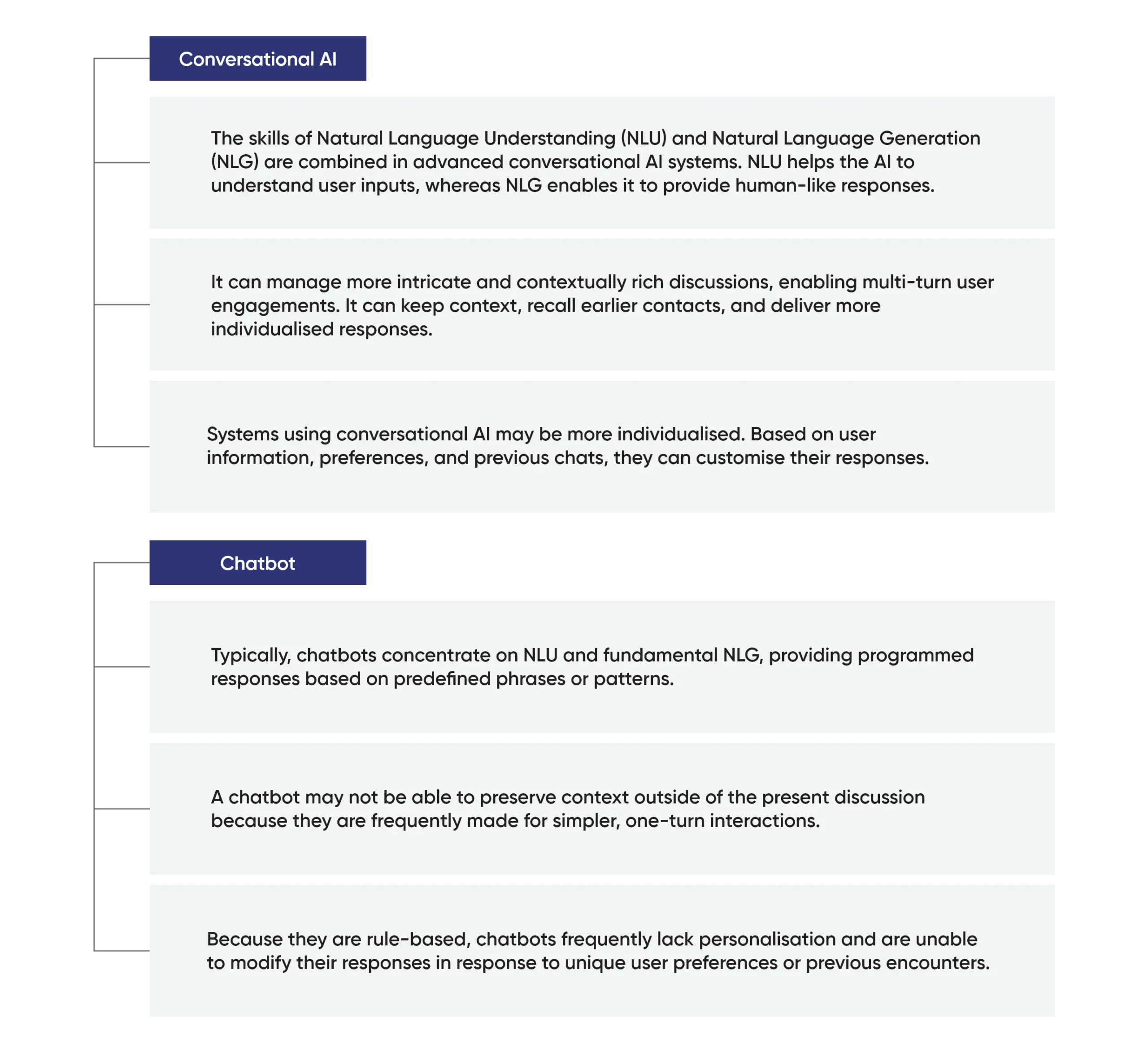What is Conversational AI?
A group of technologies used to power human-like interactions through automated messaging and voice-activated applications is referred to as conversational artificial intelligence (AI), a growing subfield in AI.
Vast volumes of data, including text and speech, are used to train conversational AI systems. The system learns how to comprehend and process human language through the usage of this data. Vast volumes of data, including text and speech, are used to train conversational AI systems. The system learns how to comprehend and process human language through the usage of this data.
Advanced chatbots, or AI chatbots, are the most common kind of conversational AI. AI chatbots combine many types of artificial intelligence (AI) for more advanced capabilities, as opposed to conventional chatbots, which are built on simple software and have restricted capabilities. Conventional voice assistants and virtual agents can be improved with the use of the technology employed in AI chatbots. The technology underlying conversational AI are still in their infancy but are evolving and improving quickly.
Vast volumes of data, including text and speech, are used to train conversational AI systems. The system learns how to comprehend and process human language through the usage of this data. Vast volumes of data, including text and speech, are used to train conversational AI systems. The system learns how to comprehend and process human language through the usage of this data.
Advanced chatbots, or AI chatbots, are the most common kind of conversational AI. AI chatbots combine many types of artificial intelligence (AI) for more advanced capabilities, as opposed to conventional chatbots, which are built on simple software and have restricted capabilities. Conventional voice assistants and virtual agents can be improved with the use of the technology employed in AI chatbots. The technology underlying conversational AI are still in their infancy but are evolving and improving quickly.
Differences between Conversational AI and Chatbot
A collection of fundamental technologies for creating chatbots is called conversational AI. In other words, a conversational AI platform is the foundation upon which an application called an intelligent chatbot is constructed.
However, not every chatbot is built using conversational AI technologies. In actuality, a sizable fraction of chatbots is entirely non-conversational and human-scripted, and/or rule-based. Chatbots, virtual personal assistants, automated message systems, agent-assisting bots, and FAQ bots powered by AI are examples of applications based on conversational AI platforms.
Although conversational AI and chatbots are related technologies used to facilitate interactions between humans and computer systems, there are distinct differences between the two:
However, not every chatbot is built using conversational AI technologies. In actuality, a sizable fraction of chatbots is entirely non-conversational and human-scripted, and/or rule-based. Chatbots, virtual personal assistants, automated message systems, agent-assisting bots, and FAQ bots powered by AI are examples of applications based on conversational AI platforms.
Although conversational AI and chatbots are related technologies used to facilitate interactions between humans and computer systems, there are distinct differences between the two:

Challenges of Conversational AI Technologies
Over the past few years, conversational AI has steadily matured to the point where it can now provide businesses with outstanding business value and outcomes. Nevertheless, it poses some difficulties, such as:


It is challenging to train AI algorithms to comprehend the intricacies of human language. It is difficult for artificial intelligence to consistently read user inputs correctly due to ambiguity, slang, colloquialisms, and changes in sentence structure.


Accurately determining the user’s intent before responding to a query is essential. Answers that are unnecessary or incorrect can result from misinterpreting purpose.


Conversational AI must incorporate context awareness to maintain meaningful discussions. However, it can be challenging to comprehend and remember context across several turns and themes, particularly in dynamic real-world situations.


Access to user data is necessary to customize answers to specific users. Conversational AI developers constantly need help to strike a balance between personalization and user privacy concerns.


Creating conversational AI systems that can communicate effectively in multiple languages and comprehend different cultural references is difficult.


Most conversational AI systems perform well within particular areas but struggle when tasked with tasks outside of their purview. It’s still challenging to develop flexible systems that can handle a variety of subjects.


To deliver valuable services, conversational AI must be integrated with various back-end systems, databases, and APIs. This needs a careful design that takes data security and system compatibility into account.
How to Create Conversational AI?
Thinking about your potential customers’ interactions with your product and the most common queries they might have is the first step in developing conversational AI. You can then direct them to the relevant information using conversational AI capabilities.
Begin by understanding your use cases and requirements
The initial phase towards creating conversational AI is recognizing your organization’s specific requirements and use cases.
- What do you want your chatbot to accomplish?
- What kind of dialogue would you like it to be capable of having?
- What information do you need to gather and monitor?
You can choose the best method for building your chatbot by defining these needs.
Data gathering
Collect relevant and varied datasets for your AI model. This data should comprise user inputs and subsequent replies for the AI to learn from instances.
Select the appropriate platform and tools
Numerous platforms and toolkits are available for building conversational AI. Select the platform that best meets your needs, as each offers benefits and drawbacks.
Preprocess the data
Cleaning and preprocessing it will guarantee that it is accurately formatted and error-free.
Model training
Using the preprocessed data, train your AI model using the selected platform and tools. In this procedure, the model’s performance is optimized using machine learning methods.
Integration
Add your conversational AI to the platform or application of your choice, such as a website or mobile app.
Debugging and testing
Test your conversational AI rigorously to find and solve any errors or problems.
Track and update
Track the performance of AI and user interactions, then change as necessary. Regular updates will improve the model’s capabilities and allow it to react to changing user needs.












